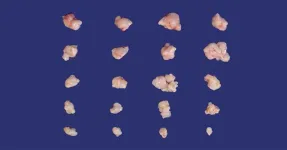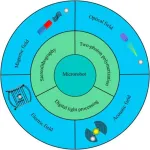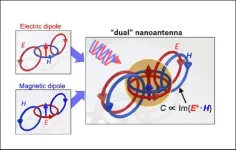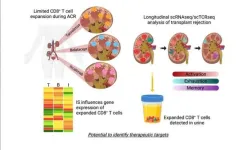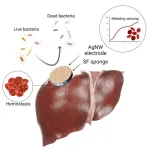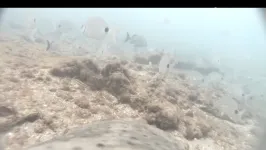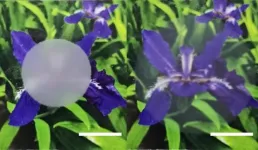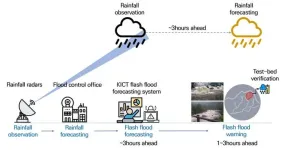(Press-News.org) FOR IMMEDIATE RELEASE
Johns Hopkins Medicine scientists say they have developed a nanoparticle — an extremely tiny biodegradable container — that has the potential to improve the delivery of messenger ribonucleic acid (mRNA)-based vaccines for infectious diseases such as COVID-19, and vaccines for treating non-infectious diseases including cancer.
Results of tests in mice, reported June 20 in the Proceedings of the National Academy of Sciences, show that the degradable, polymer-based nanoparticle carrying an mRNA-based vaccine, when injected into the bloodstream of mice, was able to travel to the spleen and activate certain cancer-fighting immune cells in a targeted way.
The researchers also found that mice with melanoma survived twice as long, and twice the number of mice with colorectal cancer survived long-term, following an injection of the Johns Hopkins-made nanoparticles compared with mice that received control treatments.
In addition, the scientists found that throughout the mice, about half of the specialized immune cells responsible for recognizing and destroying unhealthy cells such as those infected with viruses or cancer, had been activated and primed to recognize the specific invading cancer cells.
Nanoparticles made from lipids (a type of fatty acid) are the basis for mRNA COVID-19 vaccines. Such lipid-based, preventive vaccines are typically injected into muscle.
However, while muscle contains many cells capable of expressing mRNA that can lead to an antibody response, there are relatively few dendritic cells — immune cells that teach the rest of the immune system, in particular T-cells, to seek and destroy cancer cells. Scientists may be able to improve cancer treatment-focused vaccines by enhancing their ability to reach dendritic cells with their mRNA instructions.
Injecting lipid-based vaccines into the bloodstream has proved difficult because the vaccines tend to travel directly to the liver, where they are degraded.
“Our goal was to develop a nanoparticle that wouldn’t be sent directly to the liver and could effectively teach immune system cells to seek and destroy the appropriate target,” says Jordan Green, Ph.D., professor of biomedical engineering at the Johns Hopkins University School of Medicine.
Green explains that to make stronger vaccines for infectious disease and for noninfectious disease, such as cancer, the nanoparticle’s mRNA contents are needed to reach, enter and be expressed in dendritic cells. After the mRNA is expressed in dendritic cells, it is quickly degraded, and the resulting immune cell response can last much longer after the mRNA and nanoparticles are long gone, say the researchers.
Customarily, scientists have accomplished this cell targeting by attaching proteins to a nanoparticle that bind specifically, like a lock and key, to a target cell’s surface. However, in laboratory tests of this approach, only a small percentage of nanoparticles reach the target cell, and the scientists say there are manufacturing challenges with such approaches.
Green and his team tested various materials and ultimately decided to encase a desired mRNA in a polymer-based vessel. Polymers are repetitive groups of small molecules that form a tightly bonded chain to create a larger molecule, and they can be designed to biodegrade back to small molecules in the body. Green’s team engineered the nanoparticle’s ratio of water-loving to water-phobic molecules just right — a key to making the nanoparticle more apt to encapsulate mRNA, and making it easier to enter the target cell.
Then, Green’s team used disulfide bonds to make the nanoparticles degrade quickly inside the target cell. The polymers used to construct the nanoparticles contained end-capping molecules that have an affinity for a specific tissue type.
Finally, Green and his team added a “helper,” also known as an adjuvant, to the nanoparticle. The adjuvant helps activate the dendritic cell.
In experiments of cells grown in the laboratory, the researchers found that the nanoparticle configuration they developed was taken up by primary dendritic cells at levels about fifty-fold higher than mRNA by itself. In mice, nearly 80% of cells in the spleen that the nanoparticles reached were the target dendritic cells.
In one set of experiments, the researchers used mice with immune cells genetically engineered to glow red if the nanoparticle was opened to reveal its mRNA contents. They found that 5% to 6% of all dendritic cells in the spleen successfully took up, opened and processed the nanoparticle, and that this happened mostly in dendritic cells compared with other immune cells including macrophages, monocytes, neutrophils and T-cells.
“The immune system is designed to work through an amplified response, where dendritic cells teach other immune cells what to look for in the body,” says Green.
Later experiments showed that half of mice with colorectal cancer survived long-term after receiving two injections of the new nanoparticle formulation plus an immunotherapy drug, compared with 10% to 30% that survived after treatment with other nanoparticle formulations and an immunotherapy drug or the immunotherapy drug alone.
Of the long-term surviving mice with colorectal cancer, all of them lived without additional treatment when the researchers gave them additional colorectal cancer cells, suggesting a long-term immunological response that prevented the cancer from returning.
The researchers also found that 21 days after treatment with the new nanoparticle, 60% of the cell-killing T-cells in the mice were armed to recognize and attack the colorectal cells. Similarly, in mice with melanoma, about half of the same type of T-cells were primed to attack melanoma.
“The nanoparticle delivery system was able to create an army of T-cells that can recognize cancer-linked antigen,” says Green.
“This new nanoparticle delivery system may improve the way vaccines are given for infectious disease, and it may open a new avenue for treating cancer as well,” Green says.
Other contributors to the research are Elana Ben-Akiva, Johan Karlsson, Shayan Hemmati, Hongzhe Yu, Stephany Tzeng at Johns Hopkins, and Drew Pardoll at the Johns Hopkins Bloomberg-Kimmel Institute for Cancer Immunotherapy and the Kimmel Cancer Center.
This work was supported in part by grants from the National Institutes of Health (R01CA228133, P41EB028239, R37CA246699, F31CA250367), the Goldhirsh-Yellin Foundation, the Swedish Research Council international postdoctoral grant, and the Johns Hopkins Bloomberg-Kimmel Institute for Cancer Immunotherapy.
Ben-Akiva, Karlsson, Tzeng and Green are coinventors on patents the Johns Hopkins University filed on technologies related to this research.
Green and Tzeng are founders and hold shares of stock in OncoSwitch Therapeutics. Both Green and Tzeng serve as board of director members to OncoSwitch Therapeutics. Green is a founder, equity holder and paid consultant for Cove Therapeutics LLC. Green is a founder, equity holder and serves on the board of directors for WyveRNA. The results of the study discussed in this news release could affect the value of OncoSwitch Therapeutics, Cove Therapeutics and WyveRNA. Under licensing agreements between Cove Therapeutics and the Johns Hopkins University and WyveRNA and the Johns Hopkins University, Green and Tzeng are entitled to royalty distributions related to technology described in the study discussed in the news release.
END
Scientists design a nanoparticle that may improve mRNA cancer vaccines
Tests in mice with melanoma and colon cancer show the tiny particle creates an “army” of immune cells that carry vaccine’s instructions, say the researchers
2023-06-28
ELSE PRESS RELEASES FROM THIS DATE:
Undergrad-driven project reveals drought’s effects on painted turtles
2023-06-28
A projected rise in droughts could muddy the waters for painted turtles and some fellow freshwater-dwelling reptiles, says 11 years of data collected by 50-plus undergraduates from the University of Nebraska–Lincoln.
Two recent studies based on the data suggest that drought can lower the survival odds, slow the growth and even skew the ratio of female-to-male painted turtles inhabiting the ponds of the Cornhusker State. Those outcomes emerged despite the water level of a sampled pond in southwestern Nebraska remaining relatively steady throughout the observed periods ...
One-two punch: Novel drug pairing could beat pancreatic cancer
2023-06-28
Mutations in the KRAS gene are the major driver of pancreatic cancer. The resulting protein controls multiple signaling pathways involved in cell growth and survival. In cancer, the gene is mutated to be permanently “on,” driving cells to excessively multiply and form tumors.
New drugs have recently been developed to inhibit KRAS and appear to be therapeutically promising. However, pancreatic cancer is especially prone to drug resistance. Most drugs only work for a short period of time before the cancer finds its way around them.
Previous experiments revealed a potential reason why: a group ...
Field-controlled microrobots fabricated by photopolymerization
2023-06-28
A review paper by scientists at the Beijing Institute of Technology summarized the recent research on field-controlled microrobots fabricated by photopolymerization.
The new review paper, published on Jun. 6 in the journal Cyborg and Bionic Systems, provided an overview the photopolymerization technologies utilized in the fabrication of field-controlled microrobots and introduced the photopolymerized microrobots actuated by different field forces and their functions.
“Field-controlled microrobots have attracted extensive research in the ...
Developing a nano-antenna that forms a near field of circularly polarized light: Promising applications in highly sensitive sensing and asymmetric photochemical reactions for molecular chirality
2023-06-28
Main Points
The research group proposed and tested a nano-antenna that uses the specific optical resonance of dielectric nanoparticles to form a near field of circularly polarized light.
This technique bolsters the circularly polarized light-selective response of chiral molecules.
The results of this study should provide applications in chirality analysis and asymmetric photochemical reactions for biomolecules, chemical substances, and pharmaceuticals.
Research Background
“Chirality” refers to the property of a substance that cannot be superimposed on its mirror image. Since the mirror image isomers of chiral molecules ...
Research reveals novel insights into transplant rejection and new drug development targets
2023-06-28
CINCINNATI -- Imagine a day when a urine test could inform a doctor precisely why a kidney transplant patient was experiencing organ rejection and suggest the best medication for specifically addressing the problem.
That day took a leap closer to reality thanks to a remarkable set of single-cell analyses that have identified the most specific cellular signatures to date for kidney transplant rejection. The findings were detailed May 25, 2023, in JCI The Journal of Clinical Investigation.
The study results reflect eight years of teamwork led by experts at Cincinnati Children’s and the University of Cincinnati College of Medicine with contributions ...
All-in-one device for hemorrhage control
2023-06-28
(LOS ANGELES) – June 28, 2023 - A multi-faceted device for effectively treating deep, non-compressible, and irregularly-shaped wounds has been engineered by the scientists at the Terasaki Institute for Biomedical Innovation (TIBI). As outlined in their recent paper in Advanced Science, the device provides rapid hemorrhage management, has minimal inflammatory effects, and provides infection control. It also has tunable biodegradation rates, making it usable for both internal and external use, and features sensing capabilities for long-term hemorrhage monitoring. This versatile device is highly beneficial ...
Boom! Detecting gregarious goliath groupers using their low-frequency pulse sounds
2023-06-28
From growls to pulses to booms, whales, fish and crustaceans all produce sounds. In fact, more than 800 species of fish are capable of making noises for a variety of functions such as courtship and mating, defending their turf or responding to threats. Each of these species has a characteristic waveform that is unique to their “calls.” As such, detecting structures in these signals can be used to identify the sounds of different species.
Classifying sounds produced by fish will help to understand how they respond to environmental changes ...
Squid-inspired soft material is a switchable shield for light, heat, microwaves
2023-06-28
With a flick of a switch, current technologies allow you to quickly change materials from being dark to light, or cold to hot, just by blocking or transmitting specific wavelengths. But now, inspired by squid skin, researchers in ACS Nano report a soft film that can regulate its transparency across a large range of wavelengths — visible, infrared and microwave — simultaneously. They demonstrated the material in smart windows and in health monitoring and temperature management applications.
Unique to the skin of squid and other cephalopods, iridocytes and chromatophores reversibly ...
Forecasting flash floods an hour in advance
2023-06-28
Korea has recently seen a surge in localized torrential rain and floods due to global warming. Frequent flash floods are hard to forecast and, when forecast, the accuracy is low. This often leads to major disasters that take hundreds of lives, as seen in Germany and China (Henan) in July 2021. Floods are one of the deadliest types of natural disasters, but climate change has made the forecasting of them even more challenging.
Researchers at the Korea Institute of Civil Engineering and Building Technology (KICT, President Kim Byung-Suk) have developed a system that can forecast ...
SNMMI keeps “Eye on the Patient” at 2023 Annual Meeting
2023-06-28
Reston, VA (July 28, 2023)—The Society of Nuclear Medicine and Molecular Imaging (SNMMI) hosted nearly 8,000 physicians, technologists, pharmacists, laboratory professionals, scientists and others at its 2023 Annual Meeting, themed “Eye on the Patient,” held in Chicago, Illinois.
“This year’s meeting offered attendees world-class scientific research, education, and exhibits as well as one-of-a-kind networking opportunities that will ultimately help us serve our patients better,” said Helen ...
LAST 30 PRESS RELEASES:
New prostate cancer trial seeks to reduce toxicity without sacrificing efficacy
Geometry shapes life
A CRISPR screen reveals many previously unrecognized genes required for brain development and a new neurodevelopmental disorder
Hot flush treatment has anti-breast cancer activity, study finds
Securing AI systems against growing cybersecurity threats
Longest observation of an active solar region
Why nail-biting, procrastination and other self-sabotaging behaviors are rooted in survival instincts
Regional variations in mechanical properties of porcine leptomeninges
Artificial empathy in therapy and healthcare: advancements in interpersonal interaction technologies
Why some brains switch gears more efficiently than others
UVA’s Jundong Li wins ICDM’S 2025 Tao Li Award for data mining, machine learning
UVA’s low-power, high-performance computer power player Mircea Stan earns National Academy of Inventors fellowship
Not playing by the rules: USU researcher explores filamentous algae dynamics in rivers
Do our body clocks influence our risk of dementia?
Anthropologists offer new evidence of bipedalism in long-debated fossil discovery
Safer receipt paper from wood
Dosage-sensitive genes suggest no whole-genome duplications in ancestral angiosperm
First ancient human herpesvirus genomes document their deep history with humans
Why Some Bacteria Survive Antibiotics and How to Stop Them - New study reveals that bacteria can survive antibiotic treatment through two fundamentally different “shutdown modes”
UCLA study links scar healing to dangerous placenta condition
CHANGE-seq-BE finds off-target changes in the genome from base editors
The Journal of Nuclear Medicine Ahead-of-Print Tip Sheet: January 2, 2026
Delayed or absent first dose of measles, mumps, and rubella vaccination
Trends in US preterm birth rates by household income and race and ethnicity
Study identifies potential biomarker linked to progression and brain inflammation in multiple sclerosis
Many mothers in Norway do not show up for postnatal check-ups
Researchers want to find out why quick clay is so unstable
Superradiant spins show teamwork at the quantum scale
Cleveland Clinic Research links tumor bacteria to immunotherapy resistance in head and neck cancer
First Editorial of 2026: Resisting AI slop
[Press-News.org] Scientists design a nanoparticle that may improve mRNA cancer vaccinesTests in mice with melanoma and colon cancer show the tiny particle creates an “army” of immune cells that carry vaccine’s instructions, say the researchers

